
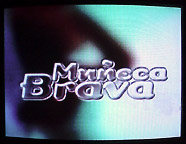

Muñeca Brava (from Argentina)
Telenovelas and Soap
in Latin America



Muñeca Brava (from Argentina)
The telenovela is perhaps the most important television program genre in Latin America. The genre was not invented in Latin America as such, as the notion is the logical extension of the serial narrative which exists in oral and written form since time immemorial to electronic media. Some well-known serial narratives in the long history of civilization are Homer's Iliad and Odyssey, the Icelandic eddas, the Niebelungenlied, Charles Dickens' A Tale of Two Cities, Tolstoy's War and Peace, Gabriel García Márquez's One Hundred Years of Solitude, Isabel Allende's House of the Spirits and the Bible.
In the United States, serial narratives appeared on radio around 1930. They were sponsored by advertisers, especially those who make laundry detergents and other household cleaning products such as Colgate and Lever Brothers, who were attracted by the large number of female housewives who listen to these programs at home. For this reason, these serial narratives were referred to as 'soap operas.' This term continued to be used when the serial narratives moved from radio to television in the 1950s. Here is an interesting observation by Robert C. Allen (see book reference at the bottom of this page):
In the US the very term soap opera marks out the serial's ironic relationship both with high art and the dirt soap is bought to eliminate. The "soap" in soap opera alludes to the use of the serial form from its earliest days to the present as an advertising vehicle for laundry detergents and household cleaning products. The "opera" in soap opera signals a travesty: the highest of dramatic art forms is made to describe the lowest. (Similarly, western movies were called "horse operas" in the 1930s).
... David Buckingham points to the tendency of serials to be "about" trash: they seem to revel in the concealment (to other characters and to the viewer) of the dirty little secrets of characters' lives. One of the most common ways for a serial character to demonstrate his or her villainy is to obtain and threaten to disseminate some "dirt" about another character: his mistaken parentage, her previous lover, his extramarital liaison, her child given up for adoption.
Due to language differences, the radio soap operas produced in the USA obviously cannot be broadcast to Latin America as they were. Nor can they just be translated directly, because there are different social mores and customs involved. Initially, Spanish-language radionovelas were produced in Cuba in the 1930s and 1940s and exported around the region, again under the sponsorship of the soap companies. Later, some countries began to produce their own radionovelas. Today, radionovelas are no longer popular as they once were. Instead, the television serial drama format known as telenovela is the most popular television program genre in Latin America.
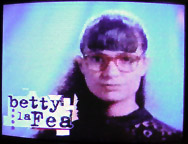
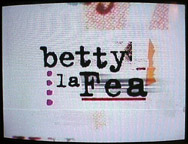
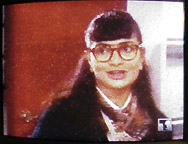
Betty La Fea (from Colombia)
In our previous article Telenovelas in Latin America, we discussed the characteristics of the viewers of telenovelas in Latin America. In short summary, the telenovela audience can be characterized as being female and less educated. In this article, we will attempt to provide some data that cuts to the core commercial interests of telenovelas --- namely, its ability to sell laundry soap/detergent and other household products.
At the outset, we have to address an important contextual difference. In the pioneer days of radio and television soap operas in the USA, the target audience was housewives who stayed at home to perform household chores during the day. Hence, the terms 'soap opera' and 'daytime drama' were synonymous. This connection grew weaker over time as more and more women who formerly stayed at home joined the labor force. This is true in both the USA and Latin America. In the present incarnation of the televised serial narrative in Latin America, the latest big-budget telenovelas are shown on prime time to obtain the largest possible audiences. This means that we will need to examine the premise that the telenovela is the natural advertising vehicle to reach laundry detergent purchasers.
We will now cite some data from the Los Medios y Mercados de Latinoamérica 1998 study. The following table shows the viewing patterns of regular telenovela viewers by time of day during the typical weekday (Monday-Friday). The numbers represent the percent of time that they spend watching television of any form, including but not restricted to telenovelas. Indeed, the regular telenovela viewers in Latin America watch more television during prime time.
| 6am-9am | 9am-12n | 12n-3pm | 3pm-6pm | 6pm-8pm | 8pm-10pm | 10pm-12m | |
| Regular telenovela viewers |
7% | 10% | 25% | 20% | 54% | 75% | 38% |
| All persons 12-64 | 7% | 9% | 22% | 20% | 45% | 67% | 35% |
(source: Los Medios y Mercados de Latinoamérica 1998)



Por Amor (from Brazil; shown as Amor Sin Limite in
Spanish elsewhere)
We would like to carefully the describe the premises of our approach to the analysis of this problem. First of all, we state that the presumed objective is to advertise laundry detergents and associated products (such as fabric softeners and bleach) in an effective manner. There are obviously many media categories and vehicles to run these advertisements in, of which the telenovelas seem to be the most obvious one.
To run any advertising campaign, we should clearly define the relevant target group (or groups) for the particular product. For laundry detergents, it is a quick reflex to name women (with some age restrictions such as 25-54) as the target group. How so? First of all, this is the conditioned response to the traditional image of the female homemaker (ama de casa) who is responsible for laundry and other household chores. Much of the actual creative works reflect this line of thinking as well. According to Robert C. Allen (see book reference below),
Characters in the soap opera commercial have, quite literally, dirty secrets, dirty laundry, dirty floors, dirty toilets, dirty bodies, dirty appliances, dirty children, dirty homes --- which require the cleansing only this particular brand and type of soap can offer. Not coincidentally, it is female characters who are associated with dirt in the commercials. According to the commercials' logic, it is their inadequacy in controlling dirt that creates a problem, and it is their responsibility to eliminate the home's sources of filth. (p.4).
However, given our stated objective, we are not trying to reach women --- we are trying to reach the purchasers of household laundry products. On one hand, some purchasers of laundry purchasers are not female (e.g. single males living alone), or at least not within the age group (25-54). On the other hand, some women 25-54 are not the purchasers of laundry products in their households (e.g. the 25 year-old daughter living with her parents). In either situation, the advertising plan based upon a target group of women 25-54 may be inefficient.
A target group such as women 25-54 is used either out of habit or necessity. The bulk of advertising dollars are spent on television, for which the audience data is usually available in the form of ratings by age/sex/socio-economic groups without access to product usage data. So a group such as women 25-54 is used out of necessity as a surrogate for the purchasers of laundry products.
In a study such as Los Medios y Mercados de Latinoamérica, the survey respondents are also asked about their product usage behavior. For example, the survey data tell us that the average Latin American household uses laundry detergent 9.3 times per week, fabric softeners 2.0 times per week and bleaching agents 3.1 times per week. This information can be used to locate the households that use these products. However, this study does even better by letting us identify the heavy users of laundry products as the following table shows:
| Laundry product/frequency | % of all households | Average # of times per week | % share of volume |
| Laundry detergent 7 or more times per week 2-6 times per week 1 or fewer times per week |
50% 37% 13% |
15.1 4.6 0.3 |
81% 18% 1% |
| Fabric softener 7 or more times per week 2-6 times per week 1 or fewer times per week |
12% 32% 56% |
8.3 2.8 0.2 |
50% 45% 5% |
| Bleach 7 or more times per week 2-6 times per week 1 or fewer times per week |
22% 38% 40% |
8.1 2.9 0.4 |
62% 37% 1% |
(source: Los Medios y Mercados de Latinoamérica 1998)
The importance of the volumetric considerations can be seen clearly for laundry detergents. The use of this product is virtually universal. However, 81% of the consumed volume is accounted by half the households. So it makes sense to concentrate on these heavy users (7 or more times per week).


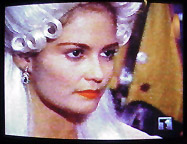
Xica da Silva (from Brazil)
There is a saying in television ratings analysis --- households don't watch television, people do. Within the households that use laundry products heavily, we need to identify the target person or persons. For the reasons stated before, it is problematic to use an age/sex qualifier (such as women 25-54). In this survey, within each household, one (or more) person(s) has(have) been identified as the principal shopper(s) (that is, the person who is responsible for purchasing most of the household products such as laundry detergent). About half of the principal shoppers are women 25-54 (compared to 26% of all persons in the population being women 25-54).
In the next table, we show the incidence of principal shoppers watching telenovelas regularly for each of the product usage groups. Considering the fact that 53% of all persons 12-64 years old say that they are regular telenovela watchers, the incidences among principal shoppers for all the heavy using groups are always higher. This would indicate that telenovelas are relatively efficient at delivering the target group of principal shoppers in households that are heavy users of laundry products.
| Laundry product/frequency | % principal shoppers watched telenovelas regularly |
| Laundry detergent 7 or more times per week 2-6 times per week 1 or fewer times per week |
62% 59% 43% |
| Fabric softener 7 or more times per week 2-6 times per week 1 or fewer times per week |
66% 62% 54% |
| Bleach 7 or more times per week 2-6 times per week 1 or fewer times per week |
60% 61% 55% |
| Total of all persons 12-64 | 53% |
(source: Los Medios y Mercados de Latinoamérica 1998)



María Mercedes (from Mexico)
We have to place the performance of telenovelas in the context against other television program genres. In the following table, we show a different set of data based upon the expressed interest in various broad television program genres. For each genre, the respondent is asked to assign a score from a 5-point scale, with 1 being 'not interested at all' and 5 being 'very interested.' The percentages in this table represents in the number of people in the target group who are 'very interested' in the television program genre. Relatively speaking, the telenovela is the most efficient genre. Furthermore, we also observe that the same decision would have been reached if we had only used women 25-54 as the target group.
|
Television |
Total Persons 12-64 |
Women 25-54 |
Principal Shoppers in Heavy Laundry Detergent Using HHs |
Principal Shoppers in Heavy Fabric Softeners Using HHs |
Principal Shoppers in Heavy Bleach Using HHs |
| News | 57% | 63% | 61% | 68% | 68% |
| Recent Movies | 39% | 33% | 31% | 33% | 31% |
| Sports | 38% | 17% | 23% | 26% | 25% |
| Telenovelas | 33% | 49% | 42% | 51% | 44% |
| Documentaries | 33% | 31% | 35% | 40% | 38% |
| Music | 32% | 30% | 30% | 31% | 29% |
| Cartoons | 27% | 30% | 25% | 28% | 26% |
| Games/quizzes | 20% | 19% | 16% | 15% | 22% |
| Variety | 19% | 20% | 19% | 21% | 20% |
(source: Los Medios y Mercados de Latinoamérica 1998)
Conclusion: Using a methodical approach, our analysis has led to the confirmation of the common lore of the telenovela being an effective advertising vehicle for laundry detergents and other household cleaning products. In this short note, we have concentrated on the commercial aspects of telenovelas, but we feel compelled to point out this particular genre has been instrumental in developing a 'national' identity for countries in Latin America in such a way that these imagined communities can define themselves in terms of as well as rally around these commonly shared televisual images of themselves.
![]()
ZONA LATINA ARTICLE
WWW REFERENCES
BOOKS
(posted by Roland Soong on 8/12/00)
(Return to Zona Latina's Home Page)